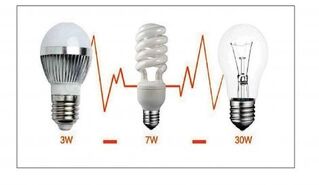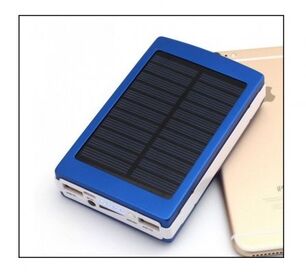Consumers are forced to save electricity by rising energy prices and environmental issues. Consumers may view the environment as a fad or a scam, but if it comes with an added price, then that should be counted on.
Of course, energy will not go anywhere, its consumption will increase, the number of sources will increase and the most harmful ones will be replaced. Savings do not mean limitation, but wise use. You can economically spend a hundred kilowatts and spend a hundred watts.
Electricity savings are achieved by a reasonable (not chaotic) organization of its use, it is the result of activity planning. And charlatan devices and "methods" advertised on the Internet sometimes have nothing to do with savings. These methods can only cause fire and electric shock.
Energy consumers are coming down
All electricity consumers can in some way be classified according to the amount of energy consumed (energy intensity). For example, this way, in descending order:
- Heating appliances;
- Lighting devices;
- Electric motors;
- Computing;
- Electronic equipment and communication devices.
Even at the household level, this classification is justified: the most electricity is consumed by boilers, stoves of various types - grills, toasters, electric ovens, then irons, dryers. Quite a lot of energy is spent on lighting. Lighting competes with refrigerators (compressor motor).
An ordinary home computer also consumes a lot, it is quite a competition to the refrigerator. Against this background, TVs, fire alarms and chargers for mobile communication devices consume the least.
Converting electricity into heat, this is the most noticeable result that can be obtained, but it is also achieved with full efficiency. if such conversion is required. The efficiency of iron is almost 100%. As for the light source, the situation is much worse - even with LED lamps, the efficiency is close to only 15%, (we can talk about close to 100% only for quantum phenomena in semiconductor LED crystal, the rest is spent on heating wires and lossesoptional: starters).
Save on heating appliances
How to save energy without depriving yourself of the benefits of civilization? As we can see, heating devices "take electricity" the most, this is the most important resource for saving. For them, energy saving methods in everyday life are indirect, but no less important. First of all, the heat must be fully utilized. For example, it is utterly unwise to boil water in a metal tank in a cold room that does not need to be heated. It is better to do this where the heat will spread through the living room.
The obtained heat must be retained completely and for as long as possible due to good thermal insulation of the premises. In European countries, for example, Germany, they are even punished for poor isolation.
With multi-tariff energy payment and the possibility of heat storage, the most expedient will be the night mode of operation of boilers and other heating devices. During the day, the heat will remain at a sufficient level. This is especially useful if residents are at work or studying during the day. In addition, by consuming energy at night, consumers equalize the load of the power grid, which positively affects its correctness and operating costs. This allows us to hope for lower prices.
Lighting savings

Let’s start with a reminder not to forget to turn off the lights where they aren’t needed. And think carefully about the position of the light source (preferably with the help of experts in this matter) in all rooms, even if they are auxiliary rooms. We then turn to the light sources that exist in our time.
First of all, it should be noted that we live in a fertile time of repulsion of voracious incandescent lamps, which heat more than they shine. Widespread use of fluorescent light sources (daylight) gives very significant energy savings, two to three times.
Fluorescent bulbs made in the form of 40 and 80 W tubes have been widespread before (since the 1970s), but mainly in public and industrial buildings.
Modern "energy-saving" home fluorescent bulbs basically E27 are the same tubes with mercury vapor and phosphorus from the inner surface of the glass. But they are twisted into a round spiral and connected by a miniature electronic muffler located at the base and performing the same functions as an iron muffler and a gas discharge starter.
But fluorescent lamps already displace LED lamps that consume two to three times less energy than fluorescent bulbs with the same light flux. They are still slightly more expensive than other types of lamps, but the market is not yet saturated with new products. Costs pay off quickly due to significant savings from their use.
Both fluorescent and LED bulbs have a very wide range that approaches daylight. This is due to the use of a primary ultraviolet source in both cases - LED lamps also use luminescence and ultraviolet light is converted into a mixture of all colors of visible light. Only in LED lamps, ultraviolet light is not generated by mercury vapor atoms, but by a semiconductor crystal.
Additional ways to save energy when solving lighting problems are on and off automation. The person is forgetful, but the technique is not. The use of dimmers (brightness control devices), photo relays, timers and motion sensors will reduce unnecessary light costs.
All of these products are in stores, sold with warranties, certificates and instructions, and have long been non-exclusive crafts, available only to qualified radio amateurs who have made them for their home.
Electric motors
In everyday life, electric motors are primarily found in refrigerators, washing machines and air conditioners. There are also pumps for heating systems and pumps for wells. All other cases: coffee grinders, drills and so on do not deserve attention, because they are turned on rarely and for a short time.
Reduction of energy consumption in case of continuous operation of electric motors is achieved by their periodic shutdown (refrigerators and air conditioners), or by using a frequency converter for asynchronous motors.
The latter are sometimes used to control pump motors for plumbing and heating systems. Since the operation of electric motors is usually associated with heat (cold), austerity measures boil down to the fact that there are fewer reasons to turn on the motor: keep the doors, vents, refrigerator and freezer doors closed.
The power that electric motors consume in everyday life is relatively small - about a few hundred or even tens of watts, here you can ignore the notorious "cosine fi", because the consumer does not pay for reactive energy.
However, asynchronous motors have one feature: a large starting current, 5-7 times higher than the rated one. This suggests that the less frequently such motors are started, the better and justifies the use of frequency drives, where they are acceptable (cases of refrigerators, especially air conditioners, do not apply to this). Do not put hot pots in the refrigerator.
Electric motors used in household appliances can be classified according to power and duty cycle (share of time in the duty cycle) as follows:
- Refrigerators, air conditioners (150–450 W, 20–50%);
- Heating pumps (60–200 W, 40–100%);
- Kitchen appliances (50-500 W, short-lived);
- Fans (10-30 W, up to 100%).
Submersible water pumps are used quite infrequently and have significant power. They are used in individual houses and cottages for wealthy owners. But even there, economic issues are not in last place. Therefore, the operation of pumps in such systems is optimized by hydraulic accumulators, frequency converters and controllers that control the operation of the water supply. Everything happens automatically.
Computers, TV and Phone Chargers

Gaming computers are able to wind the counters well not only because of the fast processor, but also because of the powerful video card that works 20 hours a day (gaming time flies fast, and as a schoolboy you may not notice how it approachedpension). . . Some people also use video cards to make money.
A typical office computer in quiet mode consumes about 200 W, a laptop - 40-60 W. This is comparable to a TV and not so significant. Nevertheless, it does not hurt to manage the power supply of such devices, especially since such capabilities have long been provided in modern smart electronics.
As for chargers for phones and other mobile devices, they can be powered by "alternative" energy sources: solar panels and small wind turbines powered by appropriate converters (including, of course, 5, 12 and 20 VDCs. The latter can be used forcharging the laptop. )
Alternative sources in everyday life are still not widespread, their capacity is very modest, and the price is high. Still, you need to start somewhere, and energy saving tips in everyday life should take into account even such a small amount.
























